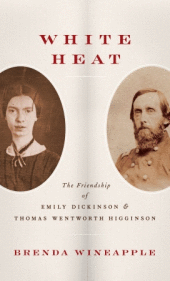 Thomas Wentworth Higginson is best known as the man who discouraged Emily Dickinson from publishing in her lifetime and butchered her poetry once she died. Editing her work with Mabel Loomis Todd for posthumous publication, he cut Dickinson’s dashes and flattened her language.
Thomas Wentworth Higginson is best known as the man who discouraged Emily Dickinson from publishing in her lifetime and butchered her poetry once she died. Editing her work with Mabel Loomis Todd for posthumous publication, he cut Dickinson’s dashes and flattened her language.
“My partially cracked poetess,” he called her — another marker of his condescension and cluelessness. Or was it?
Brenda Wineapple’s White Heat examines Dickinson’s complicated friendship with Higginson, whose biography Judith Thurman recently condensed as follows: “a man of letters, a clergyman, a fitness enthusiast, a celebrated abolitionist, and a champion of women’s rights, whose essays on slavery and suffrage, but also on snow, flowers, and calisthenics, appeared in The Atlantic Monthly.”
Dickinson’s poems — shocking, wise, and blunt, despairing but somehow also triumphant — enchanted and confused Higginson. “The bee himself,” he wrote, “did not evade the schoolboy more than she evaded me,” “and even at this day I still stand somewhat bewildered, like the boy.” Wineapple writes:
Emily Dickinson and Tomas Higginson, seven years apart, had been raised in a climate where old pieties no longer sufficed, the piers of faith were brittle, and God was hard to find. If she sought solace in poetry, a momentary stay against mortality, he found it for a time in activism, and for both friendship was a secular salvation, which, like poetry, reached toward the ineffable. This is why he answered her, pursued her, cultivated her, visited her, and wept at her grave. He was not as bullet-headed as many contemporary critics like to think. Relegated to the dustbin of literary history, a relic of Victoriana cursed with geneality and an elegant prose style, Higginson has been invariably dismissed by critics fundamentally uninterested in his radicalism; after all, not until after Dickinson’s death, when the poet’s family contacted him, did he consent to reread the poems and edit them for publication, presumably to appeal to popular taste. Yet he tried hard to prepare the public for her — “The Truth must dazzle gradually/Or every man be blind–,” as she had written — and in his preface to the 1890 volume frankly compared her to William Blake.
Dickinson responded fully to the man he thought — and she thought — he was: courtly and bold, stuffy and radical, chock-full of contraditions and loving. For not only did she initiate the correspondence, but as far as we know she gave no one except Sue more poems than she sent to him. She trusted him, she liked him, she saw in him what it has become convenient to overlook. And he reciprocated in such a way that she often said he saved her life. “Of our greatest acts,” she would later remind him, “we are ignorant –.”
To neglect this friendship reduces Dickinson to the frail recluse of Amherst, extraordinary but helpless and victimized by a bourgeois literary establishment best represented by Higginson. Gone is the Dickinson whose flinty perceptions we admire and whose shrewd assessment of people and things informed her witty, half-serious choice of him as Preceptor, a choice she did not regret….